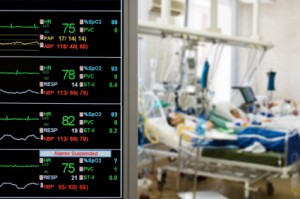Intracavitary ECG for central venous access device tip location

“Utilizing IC-ECG instead of X-ray guidance (CXR or fluoroscopy) for medium and long term CVAD tip location (PICC and port) has resulted in significant cost reduction. This strategy should strongly be considered for improving the cost-effectiveness of CVADs implantation” Pinelli et al (2025).
Intracavitary electrocardiogram guidance for PICC placement

“The IC-ECG guided method has a higher success rate on the first attempt and lower total complication for catheter tip localization in PICC placement. IC-ECG may be considered the preferred method for accurate catheter tip placement” Zhou et al (2025)
Combined intracavitary ECG and ultrasound for CVC placement – Full Text

“The combined use of ultrasound and intracavitary ECG localization in critically ill patients undergoing central venous catheterization can help increase the success rate of catheter placement, shorten the catheter placement duration, reduce the incidence of various catheter-related complications, and also reduce the length of stay and hospitalization expenses” Pan et al (2024).
Impact of sodium chloride concentration on intracavitary ECG – Full Text

“The 5.45% and 10% sodium chloride solutions are significantly superior comparing with 0.9% sodium chloride solution in the derived rate of stable intracavitary ECG, occurrence rate of characteristic P wave and time used for catheter tip localization, but there were no significant differences between 5.45 and 10% sodium chloride solutions” Dong et al (2022).
Intracavitary ECG for CVC placement

“Using IC-ECG resulted in nearly no requirement for post-insertion repositioning of CVADs resulting in savings in time and cost and virtually eliminating the need for radiographic confirmation” Alexandrou et al (2022).
Neonatal intracavitary ECG CICC tip location

“When applied to ultrasound guided CICCs, tip location by IC-ECG is applicable and feasible in neonates, and it is safe and accurate” D’Andrea et al (2022).
Intracavitary ECG for FICC placement

“Catheter withdrawal until the P wave reverted to normal indicated that a tip position close to the inferior vena cava above the diaphragm level was ideal” Duan et al (2021).
ECG for PICC tip positioning

“The application of ECGs in PICC tip positioning can improve the accuracy of catheter tip positioning and reduce the incidence of related complications” Yu et al (2021).
Effectiveness of ECG PICC tip location in patients with AF

The observational study evaluated the effectiveness in terms of reliability of the intracavitary tip location system (ITLS) method, better known as the ECG method, for the correct positioning of the catheter tip in patients with atrial fibrillation (AFIB); the method exploits the recording of the electrical potential produced by the f waves, expression of the […]
Meta-analysis of intracavitary electrocardiogram guidance for PICC placement

The intracavitary electrocardiogram method had a more favorable positioning accuracy versus traditional X-ray method for peripherally inserted central catheter placement in adult patients” Liu et al (2019). Abstract: BACKGROUND: Recently, intracavitary electrocardiogram technology has been applied to peripherally inserted central catheter placement and demonstrates many potential advantages. However, the tip positioning accuracy of intracavitary electrocardiogram […]
PICC placement using an ultrasound and electrocardiogram-guided system

To assess the cost-effectiveness of peripherally inserted central catheter (PICC) placements using an ultrasound and electrocardiogram-guided system versus external measurements and confirmatory chest X-rays (CXRs)” Keller et al (2019). Abstract: PURPOSE: To assess the cost-effectiveness of peripherally inserted central catheter (PICC) placements using an ultrasound and electrocardiogram-guided system versus external measurements and confirmatory chest X-rays […]
PICC insertion with intracavitary ECG

Ultrasound-guided venipuncture and tip location by intracavitary electrocardiogram have many advantages during the insertion of peripherally inserted central catheters, both in terms of safety and cost-effectiveness” Yin et al (2018). Abstract: INTRODUCTION: Ultrasound-guided venipuncture and tip location by intracavitary electrocardiogram have many advantages during the insertion of peripherally inserted central catheters, both in terms of […]
Modified intracavitary ECG method for detecting central venous catheter tip in atrial fibrillation patients

A modified intracavitary electrocardiographic technique can be safely used for detecting the location of the tip of central venous catheters in atrial fibrillation patients: the highest activity of the f waves is an accurate indicator of the location of the tip at the cavo-atrial junction” Calabrese et al (2018). Abstract: INTRODUCTION: The intracavitary electrocardiographic method […]
Clinical review of Sherlock-3CG® for positioning PICC

Our study could not demonstrate any specific advantage of Sherlock-3CG either as a magnetic-based tip navigation method or as an electrocardiogram-based tip location method” Pittiruti et al (2018). Abstract: INTRODUCTION: Intracavitary electrocardiogram technique is recognized as a safe, accurate, and inexpensive method for verifying the tip location of central venous access devices. While the technique […]
Intracavitary ECG guidance for peripherally inserted central catheter placement

intracavitary electrocardiogram (IC-ECG) guidance has been recently proposed for peripherally inserted central catheter (PICC) placement since it may reduce the time of placement and avoid radiological control” Santacruz et al (2018). Abstract: INTRODUCTION: intracavitary electrocardiogram (IC-ECG) guidance has been recently proposed for peripherally inserted central catheter (PICC) placement since it may reduce the time of […]

